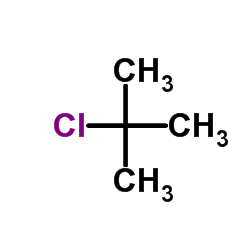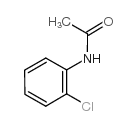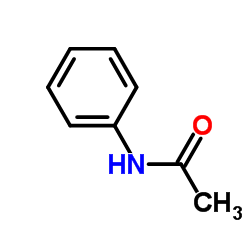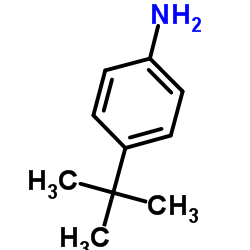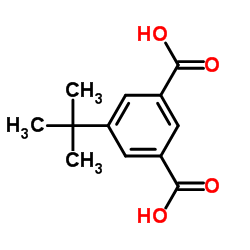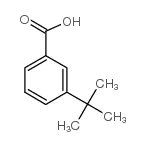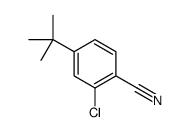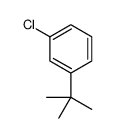42265-67-8
| Name | 4-tert-butyl-2-chloroaniline |
|---|---|
| Synonyms |
4-t-Butyl-2-chloroaniline
2-chloro-4-t-butylaniline 2-Chlor-4-t-butylanilin Aniline,4-tert-butyl-2-chloro 2-chloro-4-tert-butyl-phenylamine 4-tert-Butyl-2-chlor-anilin 4-tert-butyl-2-chloro-aniline |
| Density | 1.078g/cm3 |
|---|---|
| Boiling Point | 246.9ºC at 760mmHg |
| Molecular Formula | C10H14ClN |
| Molecular Weight | 183.67800 |
| Flash Point | 103.1ºC |
| Exact Mass | 183.08100 |
| PSA | 26.02000 |
| LogP | 3.80090 |
| Index of Refraction | 1.543 |
Synonym: Section 2 - COMPOSITION, INFORMATION ON INGREDIENTS
Risk Phrases: 20/21/22 36/37/38 Section 3 - HAZARDS IDENTIFICATION EMERGENCY OVERVIEW
Harmful by inhalation, in contact with skin and if swallowed. Irritating to eyes, respiratory system and skin. Potential Health Effects Eye: Causes eye irritation. Skin: Causes skin irritation. Harmful if absorbed through the skin. Ingestion: Harmful if swallowed. May cause irritation of the digestive tract. Inhalation: Harmful if inhaled. Causes respiratory tract irritation. Chronic: Not available. Section 4 - FIRST AID MEASURES Eyes: Flush eyes with plenty of water for at least 15 minutes, occasionally lifting the upper and lower eyelids. Get medical aid. Skin: Get medical aid. Flush skin with plenty of water for at least 15 minutes while removing contaminated clothing and shoes. Ingestion: Get medical aid. Wash mouth out with water. Inhalation: Remove from exposure and move to fresh air immediately. If not breathing, give artificial respiration. If breathing is difficult, give oxygen. Get medical aid. Notes to Physician: Section 5 - FIRE FIGHTING MEASURES General Information: As in any fire, wear a self-contained breathing apparatus in pressure-demand, MSHA/NIOSH (approved or equivalent), and full protective gear. Extinguishing Media: Use water spray, dry chemical, carbon dioxide, or chemical foam. Section 6 - ACCIDENTAL RELEASE MEASURES General Information: Use proper personal protective equipment as indicated in Section 8. Spills/Leaks: Absorb spill with inert material (e.g. vermiculite, sand or earth), then place in suitable container. Section 7 - HANDLING and STORAGE Handling: Avoid breathing dust, vapor, mist, or gas. Avoid contact with skin and eyes. Storage: Store in a cool, dry place. Store in a tightly closed container. Section 8 - EXPOSURE CONTROLS, PERSONAL PROTECTION Engineering Controls: Use adequate ventilation to keep airborne concentrations low. Exposure Limits CAS# 42265-67-8: Personal Protective Equipment Eyes: Not available. Skin: Wear appropriate protective gloves to prevent skin exposure. Clothing: Wear appropriate protective clothing to prevent skin exposure. Respirators: Follow the OSHA respirator regulations found in 29 CFR 1910.134 or European Standard EN 149. Use a NIOSH/MSHA or European Standard EN 149 approved respirator if exposure limits are exceeded or if irritation or other symptoms are experienced. Section 9 - PHYSICAL AND CHEMICAL PROPERTIES Physical State: Liquid Color: Colourless Odor: Not available. pH: Not available. Vapor Pressure: Not available. Viscosity: Not available. Boiling Point: 84 deg C @0.1mm Hg Freezing/Melting Point: Not available. Autoignition Temperature: Not available. Flash Point: Not available. Explosion Limits, lower: Not available. Explosion Limits, upper: Not available. Decomposition Temperature: Solubility in water: Specific Gravity/Density: Molecular Formula: C10H14ClN Molecular Weight: 183.68 Section 10 - STABILITY AND REACTIVITY Chemical Stability: Stable under normal temperatures and pressures. Conditions to Avoid: Incompatible materials. Incompatibilities with Other Materials: Bases, chlorates, finely powdered metals, iron, nitrates, nitrites, perchlorates, permanganates, phosphorus, potassium chlorates, steel, zinc, hydrogen peroxide, cesium acetylene carbide, cyanides (e.g. potassium cyanide, sodium cyanide), nitromethane, phosphorus trioxide, azides, iodides, benzene, carbides, moisture, fulminates, picrates, organic materials, mercuric nitride, strong dehydrating agents, alkali halides, cyclopentadiene, cyclpentanone oxime, nitroaryl amines, lithium silicides, trihydroxydiamino phosphate. Hazardous Decomposition Products: Carbon monoxide, carbon dioxide. Hazardous Polymerization: Has not been reported Section 11 - TOXICOLOGICAL INFORMATION RTECS#: CAS# 42265-67-8 unlisted. LD50/LC50: Not available. Carcinogenicity: 3,4-Dichlorophenylboronic acid - Not listed by ACGIH, IARC, or NTP. Section 12 - ECOLOGICAL INFORMATION Section 13 - DISPOSAL CONSIDERATIONS Dispose of in a manner consistent with federal, state, and local regulations. Section 14 - TRANSPORT INFORMATION IATA Shipping Name: TOXIC LIQUID, ORGANIC, N.O.S.* Hazard Class: 6.1 UN Number: 2810 Packing Group: III IMO Shipping Name: TOXIC LIQUID, ORGANIC, N.O.S. Hazard Class: 6.1 UN Number: 2810 Packing Group: III RID/ADR Shipping Name: TOXIC LIQUID, ORGANIC, N.O.S. Hazard Class: 6.1 UN Number: 2810 Packing group: III Section 15 - REGULATORY INFORMATION European/International Regulations European Labeling in Accordance with EC Directives Hazard Symbols: XN Risk Phrases: R 20/21/22 Harmful by inhalation, in contact with skin and if swallowed. R 36/37/38 Irritating to eyes, respiratory system and skin. Safety Phrases: S 23 Do not inhale gas/fumes/vapour/spray. S 26 In case of contact with eyes, rinse immediately with plenty of water and seek medical advice. S 36/37/39 Wear suitable protective clothing, gloves and eye/face protection. WGK (Water Danger/Protection) CAS# 42265-67-8: No information available. Canada None of the chemicals in this product are listed on the DSL/NDSL list. CAS# 42265-67-8 is not listed on Canada's Ingredient Disclosure List. US FEDERAL TSCA CAS# 42265-67-8 is not listed on the TSCA inventory. It is for research and development use only. SECTION 16 - ADDITIONAL INFORMATION N/A |
| Hazard Codes | Xi |
|---|---|
| Risk Phrases | 20/21/22-36/37/38 |
| Safety Phrases | 26-36/37/39 |
| HS Code | 2921420090 |
|
~72% 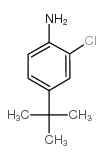
42265-67-8 |
| Literature: PHARMESTE S.R.L.; NAPOLETANO, Mauro; TREVISANI, Marcello; PAVANI, Maria Giovanna; FRUTTAROLO, Francesca Patent: WO2011/120604 A1, 2011 ; Location in patent: Page/Page column 111; 132 ; WO 2011/120604 A1 |
|
~46% 
42265-67-8 |
| Literature: Ezquerra, Jesus; Pedregal, Concepcion; Lamas, Carlos; Barluenga, Jose; Perez, Marta; Garcia-Martin, Miguel Angel; Gonzalez, Jose M. Journal of Organic Chemistry, 1996 , vol. 61, # 17 p. 5804 - 5812 |
|
~% 
42265-67-8 |
| Literature: Morton; Claff Journal of Organic Chemistry, 1956 , vol. 21, p. 736 |
|
~% 
42265-67-8 |
| Literature: Bartlett,P.D. et al. Journal of the American Chemical Society, 1968 , vol. 90, p. 2049 - 2056 |
|
~% 
42265-67-8 |
| Literature: O'Meara, Jeff A.; Jakalian, Araz; LaPlante, Steven; Bonneau, Pierre R.; Coulombe, Rene; Faucher, Anne-Marie; Guse, Ingrid; Landry, Serge; Racine, Jennifer; Simoneau, Bruno; Thavonekham, Bounkham; Yoakim, Christiane Bioorganic and Medicinal Chemistry Letters, 2007 , vol. 17, # 12 p. 3362 - 3366 |
| Precursor 6 | |
|---|---|
| DownStream 5 | |
| HS Code | 2921420090 |
|---|---|
| Summary | HS:2921420090 aniline derivatives and their salts VAT:17.0% Tax rebate rate:9.0% Supervision conditions:none MFN tariff:6.5% General tariff:30.0% |

